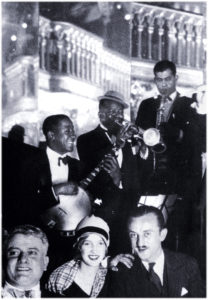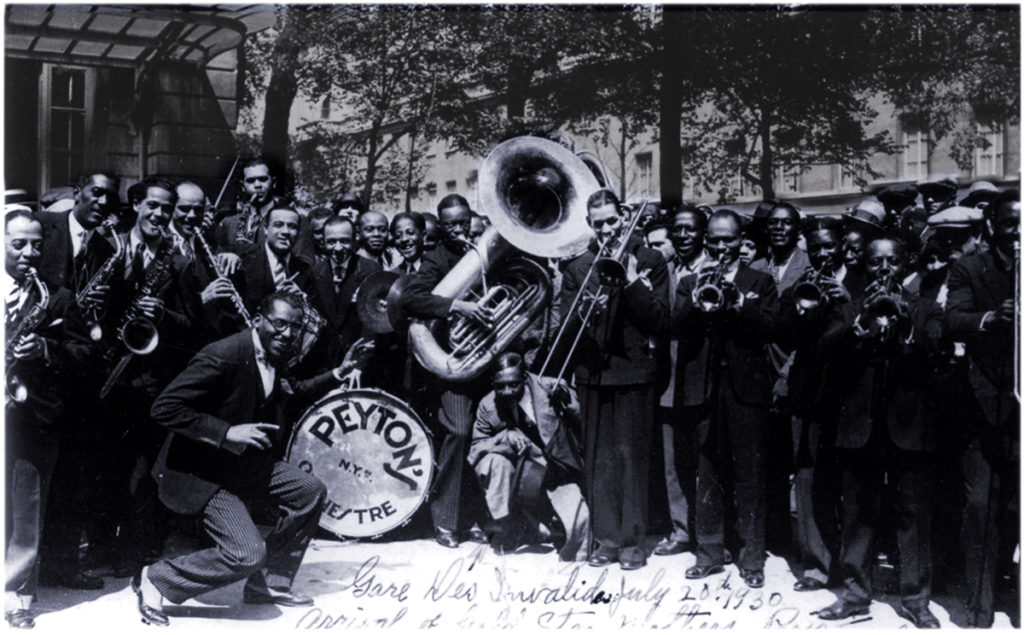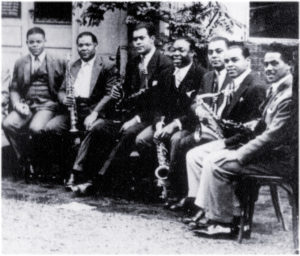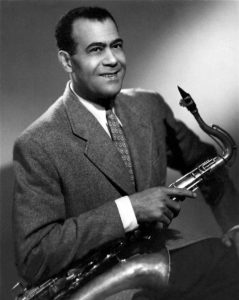Frank “Big Boy” Goudie (b. 1899 Louisiana – d. 1964 California) has been almost completely overlooked; a mere footnote in the jazz chronicles until recently. He was a skilled musician who played saxophone, trumpet and clarinet, performing jazz, swing, dance, Latin and ethnic music on three continents. His career paralleled the history of jazz itself: origins in Louisiana, migration to Europe, transition to Swing, integration with Latin music and the New Orleans revival.
A Big Life
Tall and handsome, Frank was a cultured gentleman with advanced musical skills. Fluent in French and Portuguese, he was at least six feet five inches tall, probably over 250 pounds, massive, broad and powerfully built. Traveling the world, this master musician lived four distinct musical lives:
New Orleans and the Southwest 1917-24: A journeyman jazz cornet player, by 1920 he moved to Texas and went on the road working the Southwestern states and northeastern Mexico.
Paris and Europe 1924-39, 1946-56: Arriving in Paris about the same time as Josephine Baker, he became very popular focusing on alto saxophone and later tenor, easily making the transition to Swing. For almost three decades “Big Boy” worked, recorded, played and jammed with the jazz elite of Europe — except during WW II.
South America 1939-46: Stuck on the Southern continent during the war, Frank played Latin dance music, big band samba-swing and jazz when he could, encouraging a nascent jazz movement. He and wife Madeleine operated a small cafe in Rio de Janeiro and traveled the continent.
San Francisco 1956-64: Goudie’s expressive New Orleans clarinet sound was welcomed into the thriving New Orleans Revival jazz scene.

This is certainly one of the earliest known photos of “Big Boy” Goudie at Zellis Royal Box, Paris 1927. Ferdie Allen (banjo), Cricket Smith (trumpet) and Goudie (alto sax).
Emigration to Paris, 1924
In Paris “Big Boy” was a giant among pygmies. A seasoned and professional musician with considerable show business experience, he became popular and ubiquitous working at multiple, simultaneous gigs. By the mid-1930s his reputation and fame rested firmly on his identity as a tenor saxophonist in the Coleman Hawkins manner.
Mounting data strongly suggests that Goudie was central to European jazz. Frank played in the best jazz ensembles of Europe at dozens of venues in Paris, Holland, Britain, Belgium and even Egypt. He was among the few hundred musicians and entertainers who brought jazz and black culture to France, Europe and the world.
The recent biography, BIG BOY: The Life and Music of Frank Goudie by Dan Vernhettes, Christine Goudie (his French daughter) and Tony Baldwin documents his life, career and travels. It cites more than sixty venues between 1924-39 — concerts, tours and special events where Goudie performed. Sometimes a freelance sideman, occasionally a headliner, he worked steadily for the top African-American orchestra impresarios in Europe – Benny Peyton, Noble Sissle, Leon Abbey and Willie Lewis.
Goudie was among the earliest first-rate African American jazz musicians to emigrate to Europe. His brother had passed through France returning from the First World War and recommended it to Frank. Finding work within days of arrival in Paris, he took up alto saxophone initially, eventually switching to tenor. He continued to play trumpet and took up clarinet. Between 1924 and 1956 Frank Goudie performed, toured or recorded in France and Europe (except during WW II), working with almost every significant American musician visiting or living there, and the most creative European and American artists on the Continent.
Goudie in Paris.mp3

In 1930 a massive gathering of American musicians in Paris welcomed Gold Star families from the USA. Bandleader Noble Sissle is seen crouching, “Big Boy” is above him in the second row back.
Goudie, “Le Tumult Noir” and Harlem-on-the-Seine
Frank showed up in Paris at a special time. The Montmartre area was transforming into a booming Harlem-style Jazz district. Josephine Baker’s nightclub, Bricktop’s cabaret and the jazz bars of Paris became the rage among the rich and privileged of Europe and the world.
The wild success of Josephine Baker ignited “Le Tumult Noir” — an insatiable demand for black American music, which drew dancers, entertainers, singers and musicians. During the 1920s and ‘30s Paris attracted black American artists, writers, painters and poets, becoming an outpost of the Harlem Renaissance. Even professional boxers could become major celebrities. Goudie was one of the very few musicians to arrive as a free agent, remaining longer than most.
Music in the bars, nightclubs and cabarets was the soundtrack for the “Moveable Feast” that was Paris between the wars — celebrated in literature by Ernest Hemingway. The few nightspots that weren’t outright jazz cabarets presented music from Martinique or the West Indies.

Seen in this detail from a 1928 gathering of more than two dozen jazz musicians in Paris, Goudie is third from left, Sidney Bechet to his right. Their encounters were infrequent and unproductive.
In France, as in each of his several musical lives, Goudie quickly maneuvered himself to a position near the apex of his professional and creative environment. Within a couple of years he was working at the most popular, highest profile nightclubs in Paris.
But with few exceptions the French were unable to swing or play improvised jazz until the mid-1930s. Django Reinhardt and the French federation of Hot Clubs were the nucleus of a native jazz movement. And it was Goudie who helped the Hot Clubs of France introduce Django to Parisians in the mid-1930s.
Introduction and 1939 records.mp3
“Big Boy” was likely the inspiration for this Parisian jazz icon. It was found on a flyer promoting a concert he played. The dimensions suggest his height, breadth and pigeon-toed stance. While this image might provoke mixed emotions today it signifies his formerly under-appreciated role central to a Golden Age of European jazz and swing.
- (Page 1 of 3)
- Next page →



For further detail see:
BIG BOY book
http://www.jazzedit.org/English/EBb/Big-Boy.html
Frank Big Boy Goudie – main page
http://jazzhotbigstep.com/120601.html
Goudie’s Paris
http://jazzhotbigstep.com/137101.html
Frank Goudie in Paris, 1924-39
http://jazzhotbigstep.com/752934.html
Andre Ekyan
http://jazzhotbigstep.com/293212.html
Django Reinhardt
http://jazzhotbigstep.com/242.html